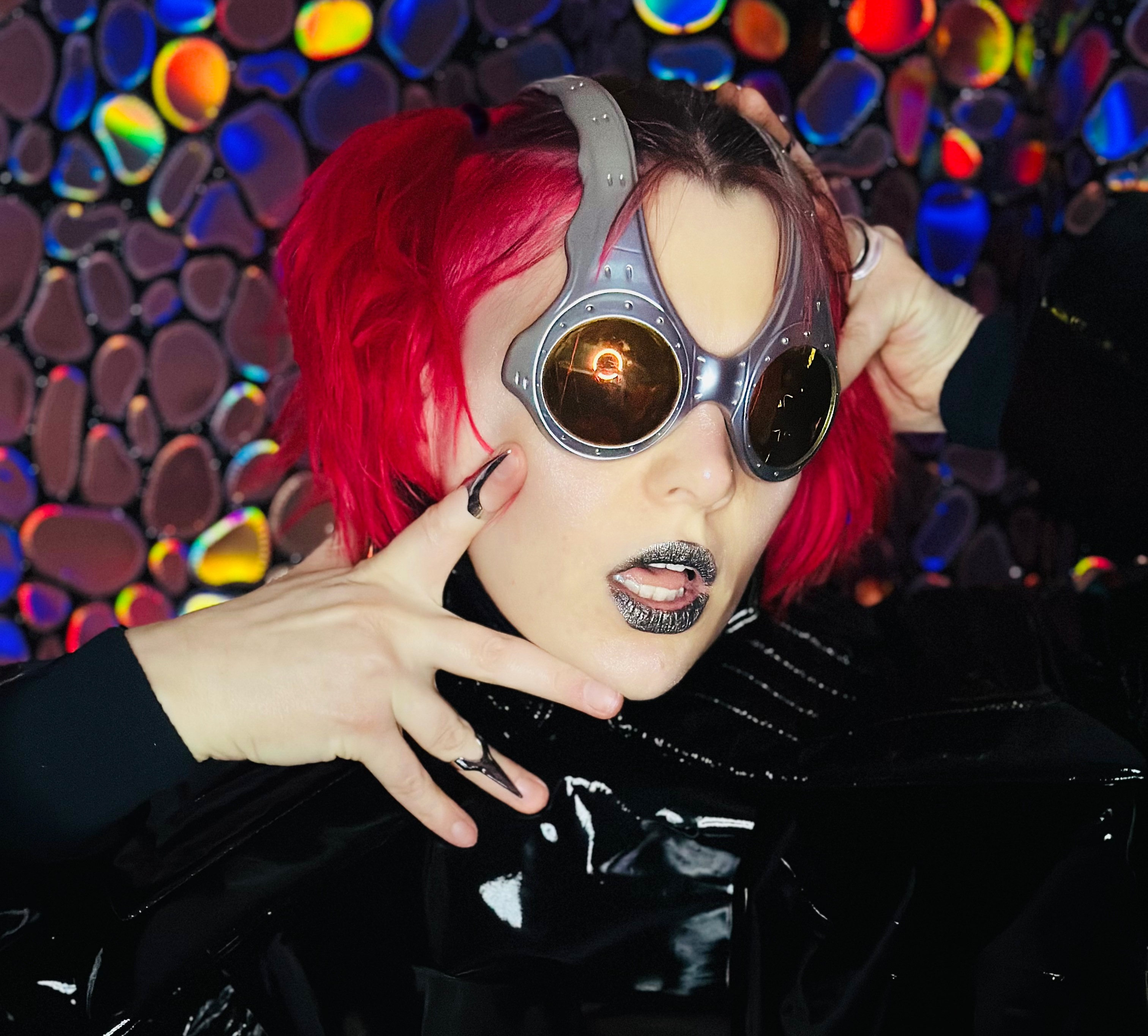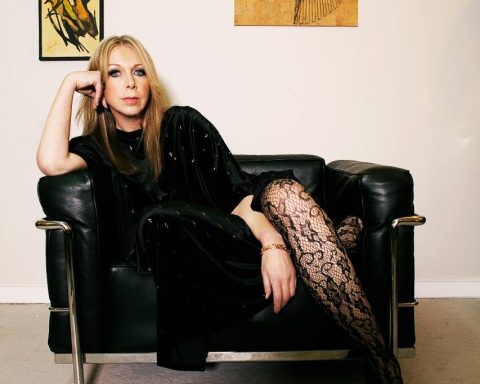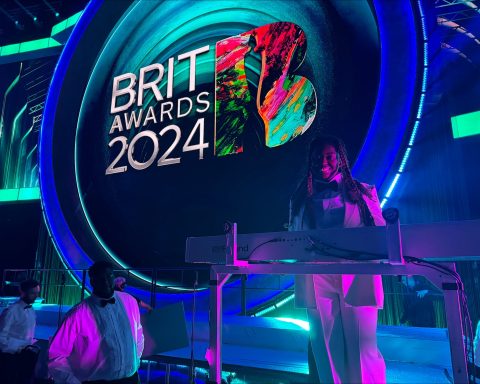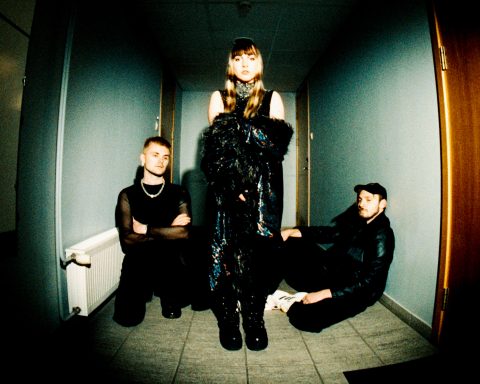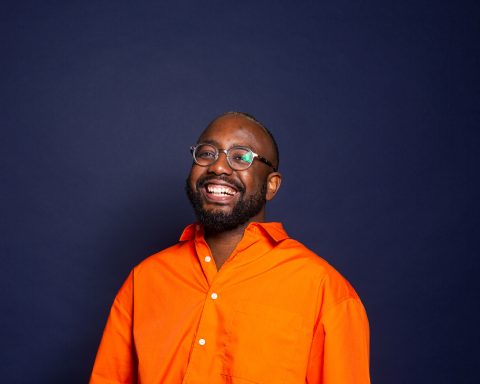Fueled by a deep love of pop music and experience building interactive art installations, Dolly Spectra is rewriting the rules of live performance. Armed in full-body motion-capture gear, she turns her body into an instrument and controls elaborate audiovisuals with her movements. Read how the artist hacked her way to livestreaming and in-person performance innovation and curated a tight-knit community on the cutting edge of technology.
A Glam Foundation
What’s your musical background?
I grew up singing and performing in Virginia and moved to LA when I turned 18. I’ve always been into “art kid music” throughout different decades. As a teenager, I fell in love with early ’70s British glam and new wave a bit later. Then, I got into the electronic side of artsy, experimental electronic pop music. I studied music formally in various ways, from choirs to jazz to pop, but I settled on electronic pop as my main interest.
How did you decide to create electronic music?
It opens a lot of doors. I took a Synth 101 class in college and learned how to create sounds using oscillators, filters, etc. Once I got a handle on synthesis, I thought, “Wow, I can do anything I want with this.” And the palette of what I could do as a producer and a songwriter became endless.
Let’s Dance
Could you explain your gestural performance rig and how it works?
Before I dive into exactly how it works, it would make sense to go through its purpose—why I’ve created such a thing. It’s not the conventional way to perform electronic pop music. I come from a background of playing in bands and theatrical singing.
Bowie and the Talking Heads are huge influences for me. Bowie and David Byrne had bands with various instruments behind them, so they could focus on being a very engaging front person and performer, almost akin to acting.
"It's not the conventional way to perform electronic pop music. I come from a background of playing in bands and theatrical singing."
I wanted to relinquish myself from just dancing and singing to playback tracks where everything in the track is completely baked in. All the visuals are often prerecorded. There’s not a lot of live give and take for the audience to engage in.
There are also people with electronic rigs using a lot of gear, and they just kind of tinker or DJ. That can be cool, but it’s not what I want to be as a performer. So how do I do something different every time but with some security of being premeditated, with room for play, and feeling like you’re playing an instrument?
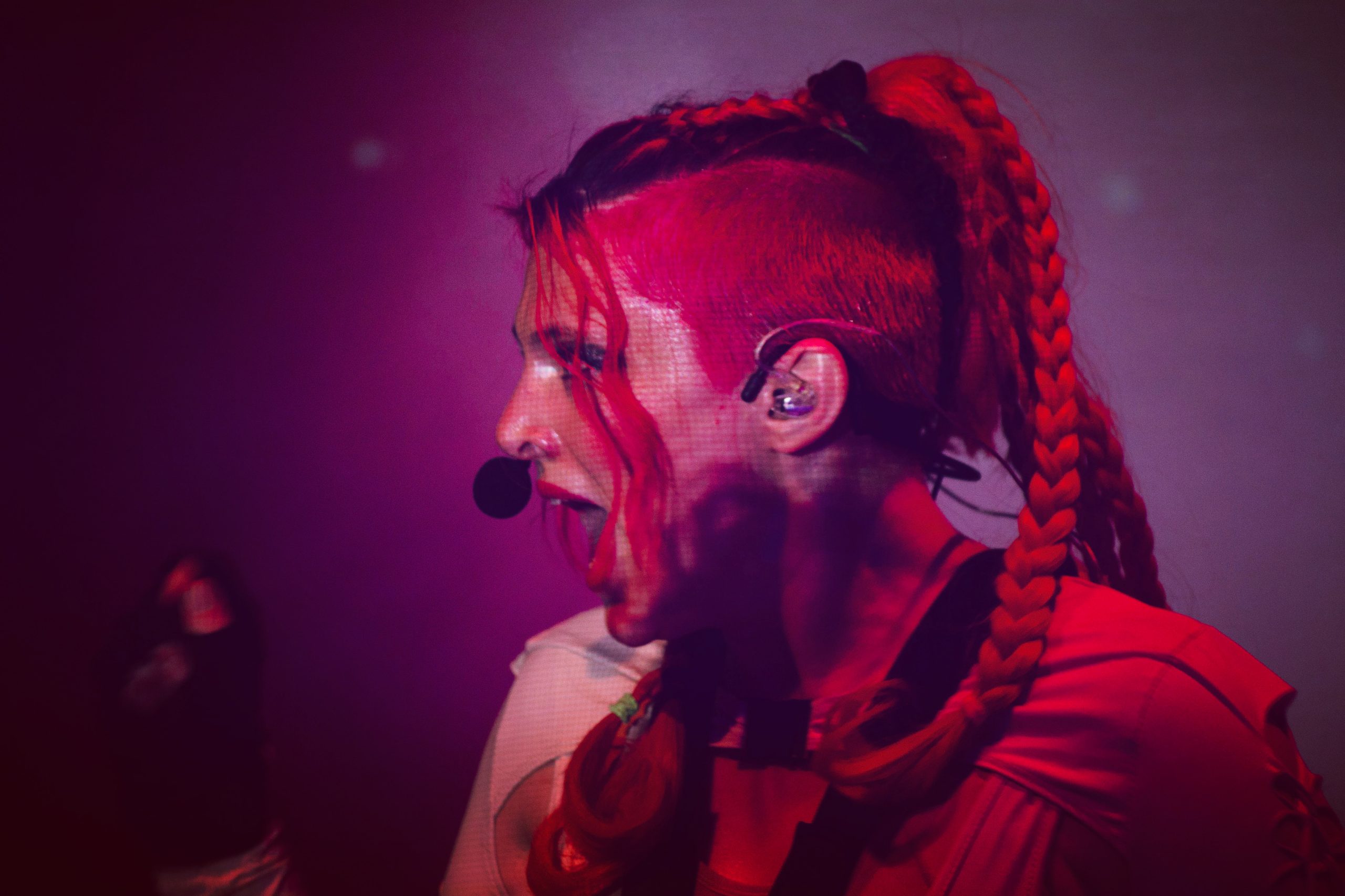
Hacking the Flow
With pop, you want to move. So, I’ve created this thing where I wear a full-body motion capture exoskeleton, and I have hacked it to control audiovisuals in real-time as part of my live performances. I have 3D avatar backing dancers that follow my moves, but instead of real people, they are projected behind me.
I have instrumental controls with parameters where I control different audio elements. I can turn my hands into a synthesizer, like a theremin. I can open and close my palms for vocal expression.
"I picked up some skills in hardware hacking and signal flow—getting things to do what I want them to do, even if they're not made for that purpose."
Several years ago, I got really into building DIY electronics with microcontrollers. I did a stint building high-tech escape rooms and interactive art installations. Eventually, I picked up some hardware hacking and signal flow skills—getting things to do what I want them to do, even if they’re not made for that purpose.
I have the Perception Neuron 3, which is the full-body suit, and MANUS Meta Quantum Mocap Metagloves for individual finger articulation. I have had to develop and adapt both for gestural audiovisuals.
Putting It Together
Data from motion capture software is sent to data and protocol switching software. It takes a type and range of data and translates it into a different type and range as needed. Then, all the MIDI parameters are sent to Ableton, and all the visuals go to Unreal Engine for manipulating 3D particle physics and my backing dancers. Finally, it’s composited in Touch Designer and projected behind me.
My audio interface is a Roland OCTA-CAPTURE. I needed something that has a decent number of inputs and outputs. I have my wireless mic and in-ear headphones, and they need to be separate tracks from those sent to the house because I want to hear the click in my ears. The OCTA-CAPTURE is robust and low-latency for live purposes. Quite a few people recommend it as an audio interface in a live setting, and I really like using it.
“I’m into exploring the possibilities of music in general, and Roland has always been at the forefront.”
Testing the Limits
How much testing has been required to incorporate gestural instruments into your performances?
About two and a half years thus far. I refer to it as a prototype because it’s a singular use case. Eventually, I want to develop these tools for other artists. The first iteration was just me in a garage, soldering things by hand, 3D printing things to wear on my wrists, and getting the accelerometers and gyroscopes to communicate with my computer.
Now, I work with a co-technician, DJ Teo, who also works with a Twitch streamer called The Sushi Dragon. Teo and I decided to switch to consumer-grade hardware because it’s been tested by research and development teams.
In the next phase, I had VR base stations so I could walk around a whole room with trackers on my wrists and belt that could give me additional data regarding the orientation of my body. That worked in testing environments and livestreams, but when I took it into nightclubs, there was a lot of infrared interference.
“What if I made this crazy thing where my body could be an instrument and also control all these visuals around me?”
Performing Art
Did you always know you wanted to combine visuals and music?
Sort of, subconsciously. When I come up with a song idea, I not only hear an entire arrangement in my head broken out into different instruments, but I see it in my head in different shapes and colors. I know I want it to look like a blue tornado with lightning inside it or a big pink planet that breaks apart into shapes, and when I punch the air, it turns a different color.
But the idea of bringing them to life only started about seven or eight years ago. I didn’t know how to do any of this stuff. I was just a kid making music and thought, “What if I made this crazy thing where my body could be an instrument and also control all these visuals around me?”
Hybrid Magic
You livestream 3D concerts as well. How do your performances and visuals differ when you stream vs. in-person performances?
The stream environment can be more controlled, so you can plan. I can do things I couldn’t do in a club. I can manipulate 3D particle physics in a livestream or beam things into the audience so there are little stars and shapes everywhere. Or make it look like I’m dancing inside a big glowing test tube. You can create all these set pieces and scenarios on a whim and have them mocked up in a day or so. You can’t do that live.
But livestreaming has limitations as well. I enjoy interacting with the crowd and being able to play into that. I have a song with this robot backing choir using stacked vocals. And with my glove, I can control the tone of expression based on what I’m doing with my hands.
When I’m performing in front of a crowd, if I can see their faces light up, I know I’m on the right track. And if I can’t see their faces, but I can feel the energy in the room, or I can hear the silence around me as opposed to chit-chat, I know that I’m in the zone. It’s a very different experience from being in a livestream where you can see the chat, but you don’t want to read it while performing.
"When I'm performing in front of a crowd, if I can see their faces light up, I know I'm on the right track."
I’m also learning to DJ. People in the scene will pick up shows as performing artists and then play after parties as deejays. And I want to do that. I have a Roland DJ-202. I can’t wait to take that out into the world and show people my flavor of that art form. I’m into exploring the possibilities of music in general, and Roland has always been at the forefront.
Multimedia Meetups
You host concerts and meetups through A/D/S/R lab; how did that group originate?
A/D/S/R is an event moniker. It’s an inclusive community I’ve helped curate within the LA underground scene. A lot of people who make music in this scene are a part of the LGBTQ community, and there’s always a need for more spaces where people can come together and express themselves safely.
There’s the flagship concert series that focuses on art-pop/hyper-pop with heavy audiovisuals. And I have a live video artist who works with all the artists to create their sets’ visuals. I’ve been able to perform, work, and become friends with some of my favorite artists, which is very fulfilling.
On the technical side, there’s a small group of us that meets once a month at Digital Debris Video Gallery in LA. It’s a group of people who are on the cutting edge of making multimedia. There are other artists doing everything from music production to animation, live video art, and other gestural instruments.
It’s cool to see these people come out of the woodwork to share their works in progress. Unless you’re looking for critical feedback, it’s more about other people looking under the hood at something interesting, experimental, and unique that you’re doing.
How has that community impacted you as an artist and a performer?
Honestly, it’s lifted me like crazy and is one of the main things that keeps me inspired as an artist. This last year has been a huge boom in terms of seeing the fruits of my labor, bringing people together, seeing the amazing things that they’re doing.
Many artists go through this phase where they feel like nobody’s listening. They know they’re making cool stuff and want to share it with the world. But getting people to listen in that initial stage is painful, especially for introverts.
"This last year has been a huge boom in terms of seeing the fruits of my labor, bringing people together, seeing the amazing things that they're doing."
But having this community for other introverted nerdy creative arts people to share with is like night and day. Not only do I have more experiences to write about, but I’m also collaborating more. I’m going to drop new songs next year and keep putting on events, going to different cities, and playing shows. It’s all a group effort at this point.
A DIY Future
How do you see electronic music morphing in the future?
There are a lot of interesting things happening with innovative technologies in the DIY spaces because they are so accessible now. It’s not just a big production with a gazillion dollars and a bunch of tour trucks full of set pieces that can do things that are compelling in a very visceral, multimedia kind of way. That’s right at our fingertips.
If you’re producing music in your bedroom now, you can also produce live visuals, sync them to the music, and go to a club. So, I feel like we’re going to see more of that. I believe in the future of VR and AR. But even more, I believe in the future of live mixed reality.
And how music sounds is going to adapt to things like that. As more people start to consider their visuals while creating a song, there will be more interesting sound design. People will craft songs not just as an audio experience, but as an audiovisual, immersed multimedia, synesthetic experience; the sky’s the limit in terms of what your imagination can create.
